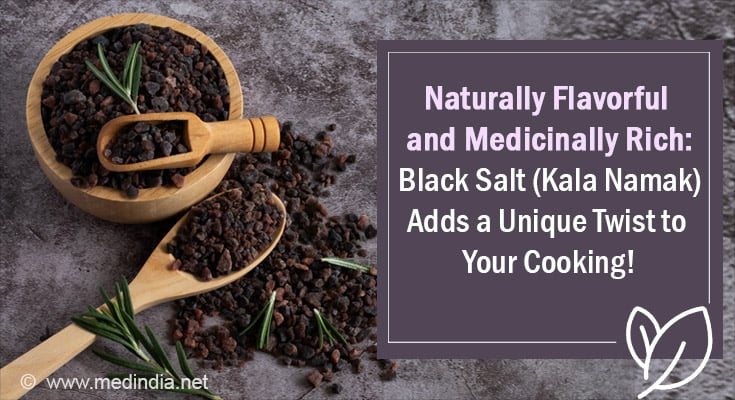- Enhances flavor in South Asian dishes and spice blends like chat masala
- Aids digestion, relieves bloating, and promotes respiratory health
- Balances body heat, supports heart health, and detoxifies the body
Black salt, also known as Kala Namak, is a unique variety of rock salt characterized by its distinctive sulfurous, pungent aroma. It is extensively used in the Indian subcontinent and is revered in Ayurveda for its perceived medicinal qualities (1✔ ✔Trusted Source
Perioperative mortality in bariatric surgery: meta-analysis
).
Advertisement
Origin and Production
The raw materials for producing Kala Namak are sourced from natural halite found in mines in Northern India, particularly in regions surrounding the Himalayas. Traditionally, the salt is processed through a reductive chemical method to enhance its color and flavor. This involves firing the raw salt in a kiln or furnace for an extended period, typically 24 hours, in a sealed ceramic jar with charcoal and specific plant materials like harad seeds, amla, bahera, or babul bark. The firing process leads to a chemical reaction that transforms the salt’s sodium sulfate content into hydrogen sulfide and sodium sulfide. The resulting salt crystals appear black and are ground into a fine powder ranging from purple to pink.
In modern production methods, the required chemicals are added directly to pure salt before firing, streamlining the process while maintaining the distinctive properties of Kala Namak.
Advertisement
Composition
Kala Namak primarily consists of sodium chloride along with trace impurities such as sodium sulfate, sodium bisulfate, sodium bisulfite, sodium sulfide, iron sulfide, and hydrogen sulfide. These impurities contribute significantly to the salt’s unique color, flavor, and smell. Iron sulfide imparts the dark violet hue, while hydrogen sulfide is the main contributor to its characteristic sulfurous aroma. The acidic bisulfates and bisulfites add a mildly sour taste.
Advertisement
Uses and Health Benefits
1. Culinary Uses
Seasoning:
Kala Namak is extensively used as a seasoning in South Asian cuisines, adding a unique flavor to dishes like chaats, chutneys, salads, and savory snacks.
Ingredient in Spice Blends:
It is a key component of chat masala, imparting a characteristic sulfurous aroma to the spice blend.
Enhancer for Fruits and Snacks:
Sprinkling Kala Namak over fruits like mangoes or incorporating it into snacks enhances their taste.
In Beverages:
It is used to flavor cooling summer drinks like jaljeera, adding a refreshing touch.
2. Medicinal and Therapeutic Uses
Digestive Aid:
Kala Namak is believed to aid digestion, relieve intestinal gas, and alleviate symptoms of gastritis and bloating.
Laxative:
It acts as a natural laxative, promoting bowel regularity and relieving constipation.
Respiratory Health:
Inhaling salt with properties similar to Kala Namak is believed to cleanse the nasal and throat passages, aiding in respiratory conditions likesinusitis and allergies.
Skin Care:
Used in skincare routines, it helps exfoliate dead skin cells without causing dryness, improving skin texture.
Joint Disorders:
When applied externally, Kala Namak is used to alleviate joint pain and stiffness.
3. Health and Wellness
Cooling Spice in Ayurveda:
It is considered a cooling spice in Ayurvedic medicine, used to balance body heat and aid in reducing inflammation.
Anti-flatulent Properties:
Kala Namak is believed to reduce flatulence and bloating, making it beneficial for digestive discomfort.
Heart Health:
It may help regulate cholesterol levels and blood pressure contributing to overall cardiovascular wellness.
Detoxification:
The mineral content in Kala Namak is thought to assist in detoxifying the body by promoting urination and flushing out toxins.
4. Alternative Health Practices
Salt Therapy:
Kala Namak is used in modern salt therapy practices to alleviate respiratory issues such as asthma and allergies.
Ayurvedic Remedies: It is a component of various traditional Ayurvedic remedies for a wide range of ailments, from digestive disorders to skin problems.
5. Culinary Tips and Techniques
Flavor Enhancement:
Use Kala Namak sparingly to enhance the flavour of dishes, particularly those with fruit or vegetable bases.
Substitute for Common Salt:
Replace regular table salt with Kala Namak in recipes to add a unique taste profile.
In Homemade Remedies:
Incorporate Kala Namak into homemade remedies like saltwater gargles or foot soaks for its therapeutic benefits.
6. Dietary Considerations
Low Sodium Option:
Kala Namak contains less sodium than common table salt, making it a preferred choice for those monitoring their sodium intake.
Weight Management:
Its mild laxative properties and low sodium content make it suitable for individuals aiming for weight management.
7. Ayurvedic Practices
Balance Doshas:
In Ayurvedic practices, Kala Namak is used to balance the doshas (body energies) and promote overall well-being.
Hormonal Regulation:
It is believed to support hormonal balance and aid in managing conditions like diabetes and cholesterol.
8. External Applications
Foot Soaks:
Adding Kala Namak to foot soaks helps in relaxing tired feet and improving skin health.
Skin Scrubs:
Use it as an ingredient in homemade skin scrubs to exfoliate and rejuvenate the skin.
Kala Namak’s uses extend beyond culinary applications, playing a significant role in traditional medicine and alternative health practices. From aiding digestion to promoting skin health and respiratory wellness, this versatile condiment continues to be valued for its unique flavor and perceived health benefits across various cultures and holistic wellness approaches. Incorporating Kala Namak into everyday cooking and wellness routines can contribute to a balanced and health-conscious lifestyle.
Reference:
- Perioperative mortality in bariatric surgery: meta-analysis
– (https://pubmed.ncbi.nlm.nih.gov/34297806/)
Source-Medindia










